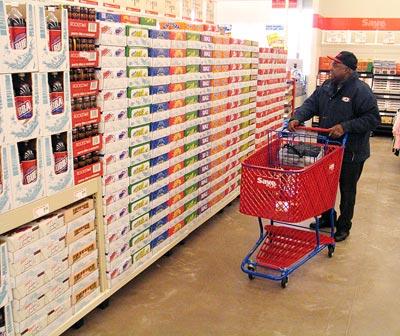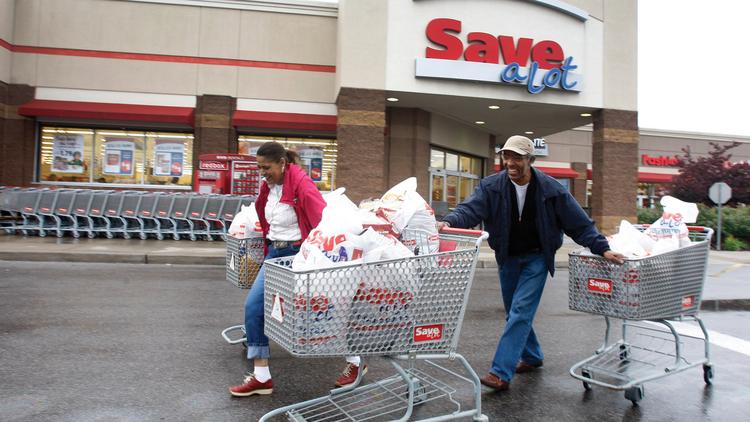It just seems to be that those who are pinching pennies would be better off buying raw ingredients in bulk and cooking from scratch at home.





Posted on 01/16/2017 5:17:34 AM PST by Iron Munro
Betty Duffey has a half-dozen several grocery stores vying for her business near her neighborhood in southern Pinellas County.
Publix Supermarkets is 2.5 miles down the road and she'll pass by a Winn-Dixie and a Walmart Neighborhood Market on the way there. Two miles in the other direction is an Aldi and a Walmart Supercenter. But Duffey, 63, does most of her grocery shopping at Save-A-Lot.
It's the closest grocery store to her house, but it's also the cheapest.
"I'm on disability and really have to watch how I spend my money," Duffey said. "At Publix, I'd spend $200 a month for groceries. At Winn-Dixie, I'd spend probably around $150. But at Save-A-Lot, I'll spend $80 for the same amount of food."
Previous coverage: Grocery wars: How many supermarket chains can Florida handle?
Save-A-Lot has operated supermarkets in Florida since the '80s, managing mostly to fly under the radar. But in recent years, the Missouri-based discount grocery chain known for its discount prices and private labels on staple items from milk to spaghetti, has moved into Florida in a big way. Save-A-Lot made a push to double its number of stores in the southeast in 2009, and within three years opened 100 stores, including dozens more in Florida and a second distribution center. Florida is now Save-A-Lot's largest market with more than 150 stores.
The company's stores are smaller than the average Walmart or Winn-Dixie, and they're often located in older shopping centers in parts of town where Publix Supermarkets has avoided. Because of this, coupled with Florida's average wages still lagging behind the national average, Save-A-Lot has been able to carve out its own niche.
"Groceries are relatively inelastic in that people can eat less, but they still have to buy food," said Steve Kirn, a lecturer who teaches classes on retail at the University of Florida. "Save-A-Lot is attractive because they are often the only grocery stores in a low-income market. But no matter where you live, their prices are pretty attractive."
Save-A-Lot began opening stores in Florida in the mid 1980s. Most of their early locations looked like a hybrid between a grocery store and a convenience store, and were found mostly in rural communities like Plant City and Brooksville.
"Our goal is to be a neighborhood grocery store, which means we serve people who live within two to three miles of the store. Not that shoppers can't come from farther away, but the model is based off providing access to groceries to those who live in a close proximity," said Chon Tomlin, spokeswoman for Save-A-Lot. "The theory is that if you have to run up the street to get a gallon of milk, we want you to come to Save-A-Lot. We'll have the lowest prices on those core, staple grocery items and we're the closest to home."
The company's business strategy has stayed the same even with its rapid growth. Save-A-Lot has opened more urban stores, including several in Tampa, St. Petersburg and Clearwater, but they still serve areas that are often considered "food deserts," or densely populated communities where it is difficult to buy affordable or good-quality fresh food.
"Save-A-Lot almost has no direct competitor because its business is mostly stock dry items and the model is based on convenience and price," said Jeff Green, a retail analyst based in Phoenix. "Everyone else focuses on organics or fresh produce or customer service."
Related coverage: Can all these new delivery apps like Instacart and Google Express survive in Tampa Bay?
Many of the shoppers who buy from the Save-A-Lot store on Gulfport Boulevard in southern Pinellas County walk or ride bikes from their homes nearby. The store is located in a mostly empty shopping center with a Family Dollar store next door and a handful of other independent stores. However, the Save-A-Lot store stays busy nearly all hours of the day. In a marked contrast to the atmosphere of a typical suburban supermarkets, an armed security guard stands at the front of the store.
"By moving into spaces where other grocery stores have closed or in lower-end centers where others won't go, Save-A-Lot is paying a pretty low rent," Kirn said. "That's part of how they make the formula work. They can remodel at a lower cost than building a brand new store."
Customers won't find all the extra perks at a Save-A-Lot that they see at a Publix. There's usually only a handful of employees working at the store at time. There are only four cash registers though usually only two are open at a time. Shoppers have to bag their own groceries. And most goods for sale are shelved in the cardboard boxes that they were shipped to the store in. There's no seafood department and the meat section is very modest compared to other grocery stores. Baked goods are prepared off site and shipped to the store.
"Save-A-Lot is a convenience-oriented shopping trip," said Green, the retail analyst. "It's very price oriented too. But it's for people shopping for a few things at a time, not a huge shopping trip, even if the number of customers they have in a day can be fairly high."
This "lean efficiency" model helps keep costs down so Save-A-Lot can sell items at a greater discount, Tomlin said.
"Our stores employ about 20 people, and everyone is trained to do every job instead of just being tied to one function," she added.
Save-A-Lot stores don't sell the popular name brand names seen in most other supermarkets, like Kellogg's cereal or Chobani yogurt. Instead it sells its own private label on all goods, from tomato sauce to paper towels. It's another cost- cutting measure the company capitalizes on, one that has been fairly easy to do thanks to a longtime ownership by SuperValu, one of the largest wholesale grocery companies in the country. SuperValu announced in October that it will sell Save-A-Lot to Onex Corp., a Toronto-based private equity investment firm, for $1.37 billion.
Unlike other grocery stores, Save-A-Lot offers its own franchise-type ownership program. About 75 percent of the company's 1,400 stores are owned by licensees, who own and operate the grocery store under Save-A-Lot's leadership.
But Save-A-Lot's secret might be out, as competitions heats up in the low-cost niche in Florida.
Adli, a German discount grocery chain, is opening stores in Florida at a rapid rate. While most stores are built brand new from the ground up, they often serve the same of kind of communities that a Save-A-Lot or a Walmart would, and are known for their discount prices. Lidl, another German value brand, is expected to make a big push into the U.S. for the first time this year.
"Some of these more traditional grocers, like Winn-Dixie and Publix, are starting to get hit on the lower end by discount stores like Save-A-Lot. It's one of the fastest growing segments of the supermarket industry, with newcomers like Adli continuing to grow and Lidl coming into the U.S.," Kirn said. He noted that Winn-Dixie's promotion to rollback prices on staple items last year was a move to keep their value-based shoppers. "There's clearly a big market here for house-branded items offered at a discount. Publix and others are going to start feeling the heat."
Back in Gulfport, Duffey says she sees no reason why she'd ever stop shopping at the Save-A-Lot close to her home.
"I've never bought piece of produce that wasn't fresh and the store is always clean," she said, adding that most of the tenants in her nearby apartment building shop there too. "I wish they would remodel the store to make that center nicer, but it's Save-A-Lot. They're not going to, and that's OK."
****FOOD STAMPS BUSINESS MODEL****
There was a Save-A-Lot in inner city York, PA. It closed because there was way too much shoplifting. It was replace by a ctore called C-town supermarkets, which remains open. I haven’t been in it yet. We like BJ’s and the Grocery Outlet.
Aldi is much better than Save-A-Lot.
So the free Ariel works
Sounds absolutely lovely.
There’s a New Save-a-lot near me. It’s clean, well organized, the produce is fresh and the meat selection good.
Publix = Great produce, seafood(on sale), meat( on sale), deli, bakery.
Winn-Dixie = Can't beat their meat. Gasoline credit for spending amounts and special items.
Save-A-Lot = Adequate in most items, outstanding in none. Not financially necessary for me to shop there...yet.
Aldi = Some meats, some produce OK. Not as fresh as Publix or Winn-Dixie.
Local Bodega = Excellent produce! 1/2 to 1/3 the price of Publix. (Still cannot imagine what kind of dish uses cactus, which they offer)
I went into Save-A-Lot once, looking for something which I don’t think they had.
It was a little too much of a discount store for me. There is something about the super low price stores that puts me off. The commissary on the military base is further away, but it is decent and the prices are good.
SAV-A-LOT is NOT cheaper than Aldi.
In my central FL community, there is a plethora of grocery stores: Publix on the high end, Winn-Dixie in the middle, and Sav-a-Lot, Aldi, and Wal-Mart on the low end. There seems to be enough of a market for them all.
Incidentally, none of them are anywhere near the location of Unity Dr. aka MLK; the closest grocery to there, Albertson’s, shut down three years ago.
We shop Aldi weekly. There’s a new competitor called Lidl that’s just starting. They are supposed to break ground in our town this month.
Ha! I’ve always wondered that too!
This looks like a decent answer:
http://www.mexicoinmykitchen.com/2009/06/how-to-cook-cactus-paddles-nopales-como.html
Each time I go to Save a Lot I’m amazed at what I walk out with for the price. Do they have everything? No. But you really can get some good deals in there. The key to shopping for any thing is knowing what the true cost of a product or service is. Without that knowledge you’ll never know if you’re saving money or not.
It just seems to be that those who are pinching pennies would be better off buying raw ingredients in bulk and cooking from scratch at home.





I just came back from a week in Mexico. I ate lots of dishes with cactus.
Publix is expensive.
My husband and I have shopped there when we went to FL to visit his mom, as that’s where she wanted us to shop for her, and it was way over priced.
There are prepared foods, but you can find what you need for your own cooking, such as meats, canned tomatoes, beans, spuds, pasta, etc. But Aldi has made a lot of strides in the quality department.
Disclaimer: Opinions posted on Free Republic are those of the individual posters and do not necessarily represent the opinion of Free Republic or its management. All materials posted herein are protected by copyright law and the exemption for fair use of copyrighted works.